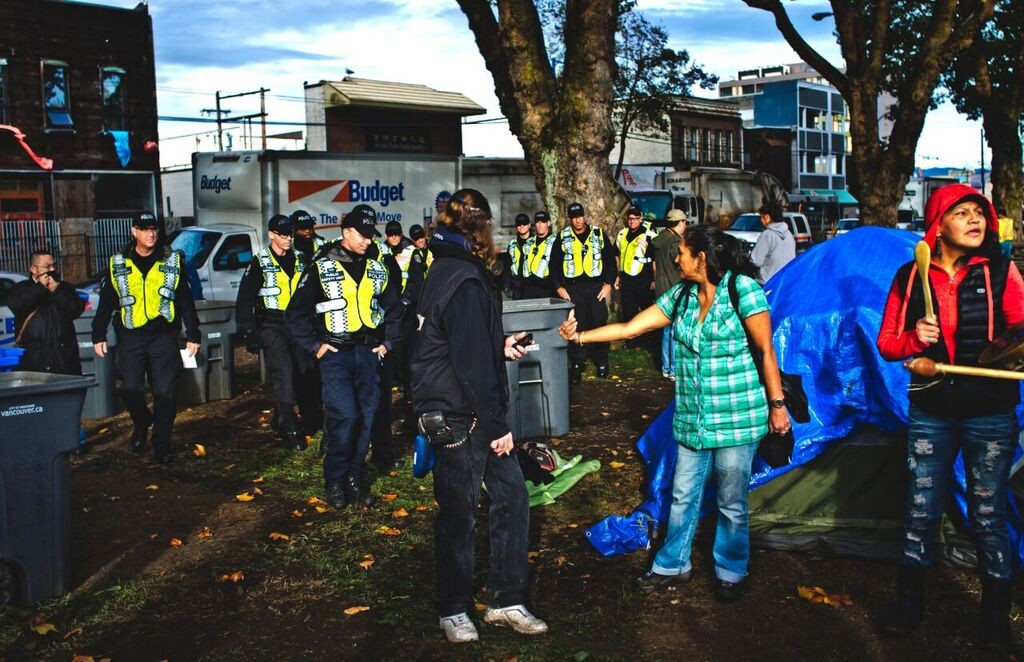But on a recent early Monday morning, the area was noticeably subdued, with only a few residents and shop owners out for a smoke, and construction workers involved in multiple condo developments trying to make their way to work.
The difference was that it was the second day of a “clean-up” of people in the Downtown Eastside, which is comprised of Chinatown, Railtown, and Gastown. According to the City of Vancouver, the crackdown carried out by the Vancouver Police Department only targets street vendors, and strives to have the least amount of impact on those “survival vendors.”
Sequel 138, a condo development at Main and Hastings with nine out of 97 units being offered at welfare rate, will be opening soon. It has been speculated that the police’s push to clear people out, which grew stronger in November, is backed by the developers. The sweep has affected more than just those selling wares; it’s also pushing out the homeless, who have nowhere else to stay but under storefronts or in back alleys.
Police finding excuses to displace vendors
One vendor, who sold all of his loose cigarettes by 7 a.m., told me the Vancouver police operate in a group of at least seven officers followed by two city vehicles and some city staff. They target the vendors, those sleeping on the street, and people dealing drugs, as well as anyone they can find an excuse to move off the street. The police department stationed two officers on the block to be present at all hours.
The police are using the cold weather as an excuse to move into an area where a multitude of items, usually recycled or found, are sold openly on the sidewalks. The informal market has traditionally been tolerated by police. Every Sunday a “junk market” takes place, essentially a legal and city approved market space that takes over a side city street.
Area 62 is a daily space run by vendors and considered a “safe haven”’ for vendors due to its cooperation with the City and registered booths. Although a secondary location similar to Area 62 is available at 501 Powell, near Oppenheimer Park, there really isn’t a market or a viable source of “survival vending” opportunity at the secondary location.
Gentrification
Development in the area has put a squeeze on many residents.
The past few years have brought a drastic amount of gentrification to the neighbourhood through high-end restaurants, coffee shops, pubs, breweries, student and art studio spaces or galleries, condos, and single room occupancies. Most notoriously, the historic Woodward’s Building was turned into condo towers and retail space, and also houses a Simon Fraser University campus, part of which is adorned with the name of a Canadian-based mining company rife with scandals: the Goldcorp Centre for the Performing Arts.
While rents increase, shelter space numbers have decreased at sites such as First United Church, harming the quality of life for many, especially for the elderly. According to Hugh Lampkin, the 2015 president of the Vancouver Area Network of Drug Users, the number of deaths of Downtown Eastside residents in the past two years is in the triple digits.
Where the people go now — whether they are without homes, living paycheque to paycheque, on welfare, using drugs, sober, alone or in a gang — is not an easy question to answer.
With little opportunity to better their situation, a few people have gone through North Fraser Pretrial Centre in Port Coquitlam; PHS, which operates dozens of buildings such as hotels, monitored clinics, an on-call mobile needle disposal van; or a federal health centre. Since the closure of Riverview, a hospital in Coquitlam specialized in dealing with mental health patients, a few years ago, hospitals with much smaller and less funded facilities in New Westminster and downtown Vancouver have taken on the onload of mental health patients.
All levels of government have failed
Last year in October, people took the housing crisis into their own hands. They set up a longhouse and a tent city in a park not far from Hastings Street. After a raid by the riot squad of the police, the City of Vancouver bought the Quality Inn, which was slated to be demolished, and used it to house a relatively low number of people.
But the hotel was leased for only two years. With over a year already passed and crackdowns of the Downtown Eastside occurring yearly, where can those impoverished go? The prices of single room occupancies are rising through rent hikes and renovictions, and there is less funding for clinics, mental health centres, and organizations like PHS. How can people go anywhere when they’re already in the last place they could go, and the only place they can feel safe because of the community around them?
If the only outcomes are time in prison, an inadequate mental ward that brings more harm than good due to lack of mental health legislature, a supervised injection site (which thankfully works), horrifically low-funded hotel services, rat- and garbage-infested back alleys, and a supposedly welfare-rated room reminiscent of jail to call home, then the people of Canada need to come together and do what the government is supposed to be doing: serve the people.
When the most vulnerable people are the least taken care of, it really shows that the government does not have a place in the streets. All levels of government have failed the people in the Downtown Eastside, and no police-enforced displacement can erase that reality. People are literally dying from both inaction and misguided action.




